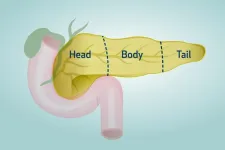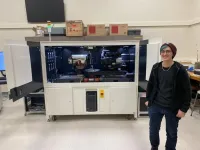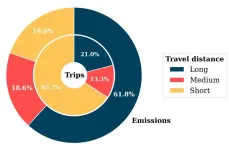(Press-News.org) Head and abdominal trauma is a leading cause of death for children. About 1%–2% of children who come to emergency departments with head or abdominal injuries require immediate intervention. These injuries are diagnosed the world over by computed tomography (CT) scans. But CT-related radiation can cause cancers later in life, and accumulated evidence suggests that CT is overused.
“There is an urgent need for validated guidelines for the safe use of CT to diagnose injured children while preventing unnecessary radiation exposure,” says Pradip Chaudhari, MD, Director of Research and Scholarship, Division of Emergency and Transport Medicine, at Children’s Hospital Los Angeles.
To help medical teams avoid unnecessary CT scans, the Pediatric Emergency Care Applied Research Network (PECARN), a federally funded network of institutions performing pediatric emergency medicine research, previously developed a set of predictive guidelines. But how well would these decision tools work in practice?
Prediction vs. reality
To validate the PECARN prediction rules, CHLA researchers collaborated on a prospective, multicenter study funded by the National Institutes of Health, enrolling thousands of children who came to the CHLA Emergency Department over a five-year period.
Nationwide, the study enrolled 7,542 children and adolescents under 18 years old who received CT scans at six pediatric emergency departments for blunt abdominal trauma, as well as almost 20,000 children with minor head trauma, who were divided by age into two groups: younger than 2 years, and 2 years and older. The primary outcome for the abdominal trauma group was intra-abdominal injury needing acute intervention, and for the head trauma cohort, clinically important traumatic brain injury. The children were evaluated against the variables of the relevant PECARN prediction rule before actual CT results were seen. The researchers found:
The intra-abdominal injury rule had a sensitivity of 100.0% and could predict at 100.0% accuracy if a child did not need a CT scan.
The traumatic brain injury rule for children younger than 2 years had a sensitivity of 100.0% for clinically important traumatic brain injuries and could predict with 100.0% accuracy if a child did not need a CT scan; for children ages 2 and older, a sensitivity of 98.8% and prediction at 100.0% accuracy if CT scan was unnecessary.
“We found both the PECARN intra-abdominal injury and traumatic brain injury prediction rules were safe and effective with a high degree of accuracy,” says Dr. Chaudhari, study co-author. “Using these guidelines will help emergency departments to safely minimize unnecessary CT scans in children.”
The researchers’ findings were published in The Lancet Child & Adolescent Health.
END
Validated rules help prevent overuse of CT scans for diagnosing traumatic head and abdominal injuries in kids
CHLA team helps validate guidelines promoting safer pediatric emergency department CT scans
2024-05-01
ELSE PRESS RELEASES FROM THIS DATE:
Closing the U.S./Mexico border during COVID-19 increased HIV transmission
2024-05-01
The border crossing separating San Diego, California, from Tijuana, Mexico, is a dynamic place. When it was closed during the COVID-19 pandemic, drug tourism from San Diego to Tijuana continued. This provided a flow of people in both directions, bringing with them not only the virus that causes COVID-19 (SARS-CoV2) but also the virus that causes AIDS (HIV). A collaborative study led by researchers from University of California San Diego and Irvine, recently published in the Lancet, found that rather than preventing the spread of disease, closing the border actually increased the rate of HIV transmission.
Injection drug use increases the risk of HIV infection through ...
Researchers at Houston Methodist find difference in pancreatic cancer cells, offering new hope for immunotherapy effectiveness
2024-05-01
A new study has found that pancreatic cancer cells are different based on their location in the pancreas, providing new information about tumors that could lead to better targeted treatments.
Pancreatic ductal adenocarcinoma (PDAC) is an aggressive cancer, and the diagnosis has dramatically increased over the last decade. It is currently the seventh leading cause of cancer deaths in men and women globally and projected to be the third leading cause of cancer-related deaths world-wide by 2030. This increase is due to several factors such as an increase in obesity and diabetes.
Houston Methodist’s ...
Withdrawal of stop-smoking pill could lead to thousands of avoidable deaths
2024-05-01
The disruption to the supply of a prescription medicine that helps people stop smoking may have led to thousands fewer people quitting each year in England, which will lead to avoidable deaths in future, suggests a new study led by UCL (University College London) researchers.
Varenicline (also known as Champix) is one of the most effective treatments to help smokers quit. It works by reducing cravings for nicotine and easing withdrawal symptoms. But its distribution was paused in July 2021 in the UK and Europe as a precaution after higher than expected levels of a potentially ...
CT-ing is believing: Zeiss Xradia 630 Versa micro-CT scanner supports materials, life sciences research
2024-05-01
Interdisciplinary researchers in Illinois, the U.S. and around the world can advance their projects with the Beckman Institute for Advanced Science and Technology's new Zeiss Xradia 630 Versa micro-CT scanner, the first of its kind with life science applications in the U.S.
Computed tomography, or CT, is an imaging technique that involves capturing a series of cross-sectional X-ray scans of an object or sample — be it a material like concrete or a biological sample like an insect or human body. Stacked on top of one another, the images non-invasively reconstruct the subject in 3D from the inside out. Microscopic computed tomography, or micro-CT, helps researchers reconstruct ...
Breakthrough in complex pain management
2024-05-01
Complex Regional Pain Syndrome (CRPS) is a chronic and debilitating pain disorder, typically considered lifelong with limited treatment options. Now, groundbreaking research finds that early detection and effective treatment can lead to significant recovery within 18 months, offering hope to millions of people worldwide.
Led by NeuRA’s Centre for Pain IMPACT and conducted in partnership with the University of South Australia, the findings could deliver life-changing outcomes for people with CRPS, with up to 80% of patients recovering ...
Astronomers share climate-friendly meeting solutions
2024-04-30
Carbon emissions associated with air travel to professional conferences make up a sizable fraction of the emissions produced by researchers in academia. Andrea Gokus, a McDonnell Center postdoctoral fellow in the Department of Physics in Arts & Sciences at Washington University in St. Louis, is advocating for a reduction of these emissions.
In a paper published in PNAS Nexus, Gokus and collaborators estimated the CO2-equivalent emissions for conference travel to all 362 open meetings in the field of astronomy in 2019.
The total is an estimated ...
Missing link in species conservation: Pharmacists, chemists could turn tide on plant, animal extinction
2024-04-30
As the world faces the loss of a staggering number of species of animals and plants to endangerment and extinction, one University of Michigan scientist has an urgent message: Chemists and pharmacists should be key players in species conservation efforts.
"Medicinal chemistry expertise is desperately needed on the frontlines of extinction," said Timothy Cernak, assistant professor of medicinal chemistry at the U-M College of Pharmacy. "Animals are dying at staggering rates, but they don't have to. Modern ...
Illinois researchers develop an AI model to reduce uncertainty in evapotranspiration prediction
2024-04-30
URBANA, Ill. – When scientists look at the Earth’s available water for ecosystem services, they don’t just look at precipitation. They must also account for water moving from the ground to the atmosphere, a process known as evapotranspiration (ET). ET includes evaporation from soil and open water pools such as lakes, rivers, and ponds, as well as transpiration from plant leaves. The difference between precipitation and ET indicates the water balance available for societal needs, including agricultural and industrial production. However, measuring ET is challenging. A new study from the University of Illinois Urbana-Champaign ...
Is it time to retire the best-before date?
2024-04-30
The inventors of a suite of tests that enable food packages to signal if their contents are contaminated are working to bring producers and regulators together to get their inventions into commercial products, with the goal of preventing illness and reducing food waste.
Though the tests would cost just a few cents per package, food producers are reluctant to add costs that consumers will ultimately have to bear, say the McMaster researchers behind an article published today in the journal Nature Reviews Bioengineering.
A system based on smart packaging, the researchers say, would save producers ...
An electrifying discovery may help doctors deliver more effective gene therapies
2024-04-30
MADISON — In an effort to improve delivery of costly medical treatments, a team of researchers in electrical engineering at the University of Wisconsin–Madison has developed a stimulating method that could make the human body more receptive to certain gene therapies.
The researchers exposed liver cells to short electric pulses — and those gentle zaps caused the liver cells to take in more than 40 times the amount of gene therapy material compared to cells that were not exposed to pulsed electric fields. The method could help reduce the dosage needed for these treatments, making them much safer and more affordable. The research appears April 30 in the ...
LAST 30 PRESS RELEASES:
New software sheds light on cancer’s hidden genetic networks
UT Health San Antonio awarded $3 million in CPRIT grants to bolster cancer research and prevention efforts in South Texas
Third symposium spotlights global challenge of new contaminants in China’s fight against pollution
From straw to soil harmony: International team reveals how biochar supercharges carbon-smart farming
Myeloma: How AI is redrawing the map of cancer care
Manhattan E. Charurat, Ph.D., MHS invested as the Homer and Martha Gudelsky Distinguished Professor in Medicine at the University of Maryland School of Medicine
Insilico Medicine’s Pharma.AI Q4 Winter Launch Recap: Revolutionizing drug discovery with cutting-edge AI innovations, accelerating the path to pharmaceutical superintelligence
Nanoplastics have diet-dependent impacts on digestive system health
Brain neuron death occurs throughout life and increases with age, a natural human protein drug may halt neuron death in Alzheimer’s disease
SPIE and CLP announce the recipients of the 2025 Advanced Photonics Young Innovator Award
Lessons from the Caldor Fire’s Christmas Valley ‘Miracle’
Ant societies rose by trading individual protection for collective power
Research reveals how ancient viral DNA shapes early embryonic development
A molecular gatekeeper that controls protein synthesis
New ‘cloaking device’ concept to shield sensitive tech from magnetic fields
Researchers show impact of mountain building and climate change on alpine biodiversity
Study models the transition from Neanderthals to modern humans in Europe
University of Phoenix College of Doctoral Studies releases white paper on AI-driven skilling to reduce burnout and restore worker autonomy
AIs fail at the game of visual “telephone”
The levers for a sustainable food system
Potential changes in US homelessness by ending federal support for housing first programs
Vulnerability of large language models to prompt injection when providing medical advice
Researchers develop new system for high-energy-density, long-life, multi-electron transfer bromine-based flow batteries
Ending federal support for housing first programs could increase U.S. homelessness by 5% in one year, new JAMA study finds
New research uncovers molecular ‘safety switch’ shielding cancers from immune attack
Bacteria resisting viral infection can still sink carbon to ocean floor
Younger biological age may increase depression risk in older women during COVID-19
Bharat Innovates 2026 National Basecamp Showcases India’s Most Promising Deep-Tech Ventures
Here’s what determines whether your income level rises or falls
SCIE indexation achievement: Celebrate with Space: Science & Technology
[Press-News.org] Validated rules help prevent overuse of CT scans for diagnosing traumatic head and abdominal injuries in kidsCHLA team helps validate guidelines promoting safer pediatric emergency department CT scans





